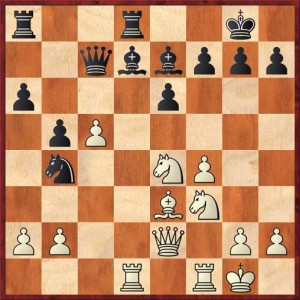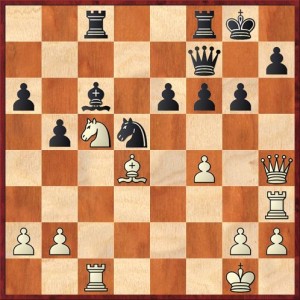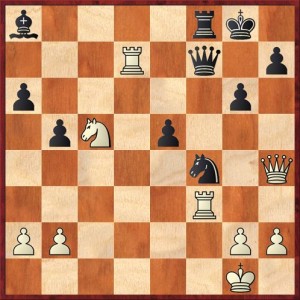Last night Linnea, Thadeus and I drove up to Milpitas for round two of the Saturday Knight Live Marathon. Our results were just the same as last week: Linnea and I won, and Thadeus drew a game he should have won.
Linnea’s game was not much of a challenge, as her opponent was rated 500. Of course, ratings don’t win or lose chess games, so perhaps more relevant was the fact that her opponent hung a rook.
Thadeus said that he had a winning position and then just hung a knight. He said he couldn’t remember the last time he out-and-out hung a piece in a tournament game. He was going to resign, but he still had a pretty good position for the piece, so he kept on playing to see what would happen, and eventually he managed to draw. He was disgusted with himself after the game, but I told him, “The key thing is that you didn’t resign.”
My game was a really high-quality game, exactly the sort of workout that I hoped for when I signed up for this tournament. My opponent was an expert named John Barnard. It was a pretty complicated game, so I won’t show you the whole thing, but I will show you three positions.
FEN: r2r2k1/2qbbppp/p3p3/1pP5/1n2NP2/4BN2/PP2Q1PP/3R1RK1 w – – 0 19
My opponent has just played 18. … Nb4. I thought for about six minutes in this position. Of course the passive 19. a3? would be terrible after 19. … Nd5, when the pawns on c5 and f4 and the bishop on e3 are all under fire. I spent a few minutes daydreaming about knight sac possibilities after 19. Ng5, but I just couldn’t see anything concrete. I finally decided that sacrifices would only work if there was already a serious bone in Black’s throat, namely a knight on d6. Didn’t Steinitz say that if you plant your knight on d6, the game will play itself? (By the way, I haven’t been able to find a reference for that quote on the Internet; does anyone know where it came from?)
So I played 19. Nd6, offering two different pawn sacrifices. I wasn’t really concerned about the pawn on a2; if 19. … Nxa2 20. Ne5 Black has wasted a tempo and White has gained a tempo for the kingside attack. It’s still not completely clear, but I was confident that something good would happen in this position.
However, Barnard played 19. … Nd5! and now White has no way to save the knight on d6. However, I did have a nice little trick here: 20. Bd4! This key move gets my bishop on a good diagonal and releases it from having to babysit the pawn on f4. The point is that if Black grabs 20. … Nxf4? then 21. Qd5 threatens mate and the knight, so White wins material.
Of course Barnard was not distracted by the f4 pawn and instead took on d6: 20. … Bxd6! 21. cd Qxd6. This is as far as I had gotten in my analysis. It was impossible to predict exactly what might happen here; I just felt that my pieces had good active squares, there were good chances for a kingside attack, and Black’s extra pawn is not exactly menacing at this point. Also, we have opposite colored bishops, so that if everything goes to hell and I remain a pawn down, I still might have a chance to draw the endgame. (Also, by the way, opposite color bishops can be useful for the attacker in the middlegame.)
So, basically an intuitive, speculative pawn sac. What happened next?
FEN: 2r2rk1/5q1p/p1b1ppp1/1pNn4/3B1P1Q/7R/PP4PP/2R3K1 w – – 0 32
Now we’ve skipped forward a few moves. White’s kingside attack has come into sharper focus, and it looks as if I can win my pawn back with 32. Nxe6, because of 32. … Qxe6?? 33. Qxh7 mate. Should I play that move?
By now I was down to only 6 or 7 minutes for the rest of the game — although with a 30-second time increment for each move, it’s not as bad as it sounds. Still, with not much time on my clock it would be easy to go for the quick solution of 32. Nxe6. But I’m glad I didn’t! Because after 32. … Bd7!, White all of a sudden has lots of problems: the knight is pinned, and the back rank is suddenly vulnerable. It looks as if 33. Re1 would be best, but then 33. … Bxe6 34. Rxe6 Rc1+! 35. Kf2 Rc2+! 36. Kf3 Nxf4!! is murderous. White can’t take the knight either way, and the rooks are forked.
I didn’t see all this, but I just saw that 32. … Bd7 was big trouble. In this position I want to be the one causing the trouble, so I looked for a good “troublemaking” move. Fortunately, I spotted one right away: 32. Ne4! The obvious threat is a fork with Nd6. (Steinitz was right again!) This move also puts some not-so-subtle pressure on f6. If Black ever moves his knight (or loses it, say, via an exchange sac) then White will get a mate in three with Nxf6+, Qxh7+, and Rxh7 mate!
The game continued 32. … Rc7 33. Bc5! This was another cool moment. If Black plays what looks like the most logical move, 33. … Rd8, then 34. Bb6! skewers the rooks. If 34. … Nxb6, then 35. Nxf6+ Kh8 36. Nxh7! wins. Black’s rook on d8 is hanging, and no matter how he chooses to defend it, he will lose his queen to a devastating discovered check.
I’m not sure whether Barnard saw this, but he played 33. ... Ba8 and now I just stepped aside with 34. Rd1. It’s amazing that Black has almost a whole rank free for his rook on f8 to go to, and nevertheless he can’t find a single safe square. So he finally gave up the exchange with 34. … Rxc5, after a very long think. The rest of the game went 35. Nxc5 e5? 36. fe fe 37. Rf3 Nf4?! (37. … Nf6 was a little better, but White is still winning) 38. Rd7! and Black resigned.
FEN: b4rk1/3R1q1p/p5p1/1pN1p3/5n1Q/5R2/PP4PP/6K1 b – – 0 38
To be honest, I was a little bit surprised that Barnard resigned here, because I was down to 3 minutes for the rest of the game (he had 11 minutes). The most cool variation, which I was hoping for, is 38. … Nxg2 39. R3xf7 Nxh4 40. Rg7+ Kh8 41. Rxh7+ Kg8 42. Rdg7 mate! This is always a great tactical trick to keep in mind when you have two rooks on the seventh rank.
Instead Black could take one of the rooks instead, 38. … Bxf3 or 38. … Nxd7 [Note added later: Sorry, a little goof here. When I wrote this I was still looking at the position after … Nf6], giving up the queen. I had thought this might be a way for him to play on, but the key point is that he can never get to an endgame with a rook and a piece versus a queen. The best he can do is R+N vs. Q+N, or R+B vs. Q+N, and these endgames are extremely hopeless because of White’s well-coordinated pieces, the weakness of Black’s pawns and the continued vulnerability of his king. So Barnard was right to resign.
A very satisfying game, except for the time management. At one point I was 40 minutes behind on the clock, which is not a very good idea.
I’d like to mention also that Barnard was a very good sportsman after the game. He told me that I had just plain outplayed him, which (as I’ve mentioned before) is something that chess players rarely admit!






{ 2 comments… read them below or add one }
Congratulations on winning a tough game against a strong opponent.
I think your note to move 20 should say If 20… Nf4 21. Qe5 threatens mate.
In the first diagram I’d be taking a long look at 19. Nfg5; I think your instincts were right and maybe you gave up on it too soon. This is one position where my preference for “sacking my opponents pieces” is the wrong approach.
* If 19 … g6 you’ve gained a vital tempo so 20. Nd6 comes with a threat to take on f7.
* If 19 … f6 20. Qh5! fg5 21. fg5 with the idea of 22. g6 h6 23. Bh6 gh 24 Qh6. If 21 … g6 22. Qh6 threatens 23. Rf7 and 23. Bd4 and 23. Nf6+.
* If 19. …Bg5 20. fg5 sets up a knight sacrifice on f6. All of your pieces are attacking his king and I don’t think he will survive long. Of course a computer will probably find a defense to these ideas, but it’s not easy.
That being said, I liked your dynamic approach of tossing the knight into d6 and creating problems for Black to solve.
In the second diagram I was wondering if, after 32. Ne4, 32 …Bd7 was still the strongest reply. Black threatens to take the rook on c1, and also threatens a double attack with e6-e5. After 33. Rxc8 Rxc8 the capture on h7 is not mate, it’s just a check, so f6 is adequately guarded. Besides that, your back rank has been weakened.
Hi Mike, Thanks, I’ll fix the Qd5/Qe5 typo. Your other comments will take more thought. After 19. Nfg5 I thought Black would just play 19. … h6. I couldn’t convince myself that any of the knight sacrifices work, and if I retreat my knight again I haven’t gained anything. I agree that 32. … Bd7 looks like a much stronger idea.
{ 1 trackback }